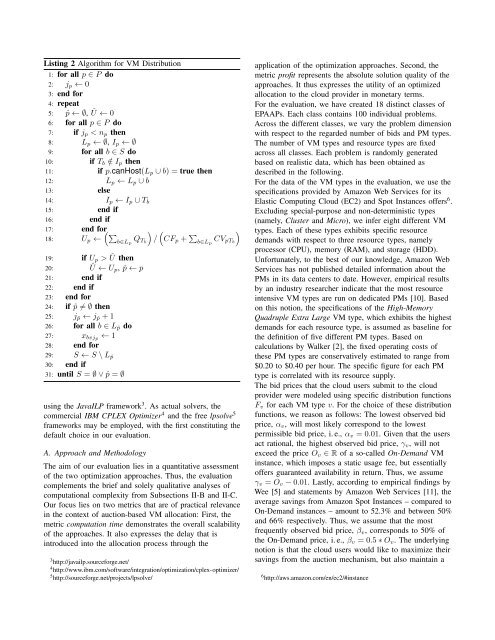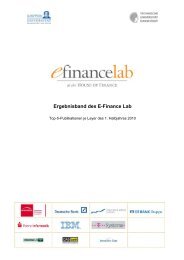Prof. Dr. Wolfgang König, Prof. Dr.-Ing. Ralf ... - E-Finance Lab
Prof. Dr. Wolfgang König, Prof. Dr.-Ing. Ralf ... - E-Finance Lab
Prof. Dr. Wolfgang König, Prof. Dr.-Ing. Ralf ... - E-Finance Lab
Create successful ePaper yourself
Turn your PDF publications into a flip-book with our unique Google optimized e-Paper software.
Listing 2 Algorithm for VM Distribution<br />
1: for all p ∈ P do<br />
2: jp ← 0<br />
3: end for<br />
4: repeat<br />
5: ˆp ← ∅, Û ← 0<br />
6: for all p ∈ P do<br />
7: if jp < np then<br />
8: Lp ← ∅, Ip ← ∅<br />
9: for all b ∈ S do<br />
10: if Tb /∈ Ip then<br />
11: if p.canHost(Lp ∪ b) = true then<br />
12: Lp ← Lp ∪ b<br />
13: else<br />
14: Ip ← Ip ∪ Tb<br />
15: end if<br />
16: end if<br />
17: end for<br />
18: Up ←<br />
� �<br />
b∈Lp QTb<br />
19:<br />
20:<br />
if Up > Û then<br />
Û ← Up, ˆp ← p<br />
21: end if<br />
22: end if<br />
23: end for<br />
24: if ˆp �= ∅ then<br />
25: jˆp ← jˆp + 1<br />
26: for all b ∈ Lˆp do<br />
27:<br />
28:<br />
xbvj ← 1 ˆp<br />
end for<br />
29: S ← S \ Lˆp<br />
30: end if<br />
31: until S = ∅ ∨ ˆp = ∅<br />
� �<br />
/ CFp + �<br />
b∈Lp CVpTb<br />
�<br />
using the JavaILP framework 3 . As actual solvers, the<br />
commercial IBM CPLEX Optimizer 4 and the free lpsolve 5<br />
frameworks may be employed, with the first constituting the<br />
default choice in our evaluation.<br />
A. Approach and Methodology<br />
The aim of our evaluation lies in a quantitative assessment<br />
of the two optimization approaches. Thus, the evaluation<br />
complements the brief and solely qualitative analyses of<br />
computational complexity from Subsections II-B and II-C.<br />
Our focus lies on two metrics that are of practical relevance<br />
in the context of auction-based VM allocation: First, the<br />
metric computation time demonstrates the overall scalability<br />
of the approaches. It also expresses the delay that is<br />
introduced into the allocation process through the<br />
3 http://javailp.sourceforge.net/<br />
4 http://www.ibm.com/software/integration/optimization/cplex-optimizer/<br />
5 http://sourceforge.net/projects/lpsolve/<br />
application of the optimization approaches. Second, the<br />
metric profit represents the absolute solution quality of the<br />
approaches. It thus expresses the utility of an optimized<br />
allocation to the cloud provider in monetary terms.<br />
For the evaluation, we have created 18 distinct classes of<br />
EPAAPs. Each class contains 100 individual problems.<br />
Across the different classes, we vary the problem dimension<br />
with respect to the regarded number of bids and PM types.<br />
The number of VM types and resource types are fixed<br />
across all classes. Each problem is randomly generated<br />
based on realistic data, which has been obtained as<br />
described in the following.<br />
For the data of the VM types in the evaluation, we use the<br />
specifications provided by Amazon Web Services for its<br />
Elastic Computing Cloud (EC2) and Spot Instances offers 6 .<br />
Excluding special-purpose and non-deterministic types<br />
(namely, Cluster and Micro), we infer eight different VM<br />
types. Each of these types exhibits specific resource<br />
demands with respect to three resource types, namely<br />
processor (CPU), memory (RAM), and storage (HDD).<br />
Unfortunately, to the best of our knowledge, Amazon Web<br />
Services has not published detailed information about the<br />
PMs in its data centers to date. However, empirical results<br />
by an industry researcher indicate that the most resource<br />
intensive VM types are run on dedicated PMs [10]. Based<br />
on this notion, the specifications of the High-Memory<br />
Quadruple Extra Large VM type, which exhibits the highest<br />
demands for each resource type, is assumed as baseline for<br />
the definition of five different PM types. Based on<br />
calculations by Walker [2], the fixed operating costs of<br />
these PM types are conservatively estimated to range from<br />
$0.20 to $0.40 per hour. The specific figure for each PM<br />
type is correlated with its resource supply.<br />
The bid prices that the cloud users submit to the cloud<br />
provider were modeled using specific distribution functions<br />
Fv for each VM type v. For the choice of these distribution<br />
functions, we reason as follows: The lowest observed bid<br />
price, αv, will most likely correspond to the lowest<br />
permissible bid price, i. e., αv = 0.01. Given that the users<br />
act rational, the highest observed bid price, γv, will not<br />
exceed the price Ov ∈ R of a so-called On-Demand VM<br />
instance, which imposes a static usage fee, but essentially<br />
offers guaranteed availability in return. Thus, we assume<br />
γv = Ov − 0.01. Lastly, according to empirical findings by<br />
Wee [5] and statements by Amazon Web Services [11], the<br />
average savings from Amazon Spot Instances – compared to<br />
On-Demand instances – amount to 52.3% and between 50%<br />
and 66% respectively. Thus, we assume that the most<br />
frequently observed bid price, βv, corresponds to 50% of<br />
the On-Demand price, i. e., βv = 0.5 ∗ Ov. The underlying<br />
notion is that the cloud users would like to maximize their<br />
savings from the auction mechanism, but also maintain a<br />
6 http://aws.amazon.com/en/ec2/#instance








